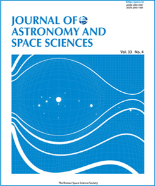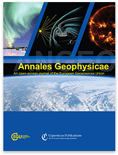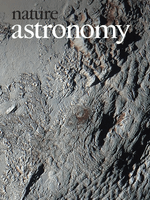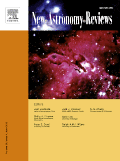
Journal of the Korean Astronomical Society
Scope & Guideline
Exploring the Cosmos: Where Discovery Meets Innovation
Introduction
Aims and Scopes
- Astrophysical Phenomena and Stellar Evolution:
Research related to the life cycles of stars, including studies on AGB stars, planetary nebulae, and the dynamics of stellar populations. This includes asteroseismic studies that probe the internal structures of stars. - Galactic and Extragalactic Astronomy:
Investigations into the properties and behaviors of galaxies, including interactions, star formation processes, and the influence of dark matter. Studies often employ multi-wavelength observations to gather comprehensive data. - Cosmology and the Large-Scale Structure of the Universe:
Research exploring the formation and evolution of the universe, including the study of cosmic rays, the dynamics of galaxy clusters, and the distribution of dark matter. - Solar and Heliospheric Studies:
Focused research on solar activity, including magnetic fields, solar flares, and coronal mass ejections, as well as their impacts on space weather and terrestrial phenomena. - Innovative Astronomical Techniques and Instrumentation:
Development and application of new observational techniques, including radio interferometry, spectroscopic methods, and advanced imaging systems, aimed at enhancing data collection in astronomy. - Historical and Cultural Astronomy:
Exploration of historical records and their implications for modern astronomy, including studies on ancient astronomical practices and their relevance to current astronomical knowledge.
Trending and Emerging
- Asteroseismology and Stellar Structure:
Recent papers emphasize the use of asteroseismic techniques to investigate stellar environments and evolutionary states, indicating a growing interest in understanding stellar interiors and their influences on stellar populations. - Multi-Wavelength Observations:
An increasing number of studies are utilizing data from various wavelengths (radio, optical, infrared) to provide comprehensive views of astronomical objects, reflecting a trend towards integrated observational approaches. - Astrobiology and Planetary Systems:
There is a notable rise in research related to the conditions for life beyond Earth, including studies on exoplanets and their atmospheres, suggesting a burgeoning interest in astrobiology and the search for habitable worlds. - Cosmic Ray and Space Weather Research:
Emerging themes in the study of cosmic rays and their interactions with solar phenomena are becoming more prominent, highlighting the importance of understanding space weather impacts on both astronomical observations and terrestrial technology. - Data-Driven Astronomy and Machine Learning:
The application of machine learning and advanced statistical methods to analyze large astronomical datasets is on the rise, indicating a trend towards data-centric research approaches that leverage computational power.
Declining or Waning
- Traditional Theoretical Models:
There appears to be a decrease in publications focusing solely on classical theoretical models without empirical validation or contemporary relevance, as the field increasingly favors data-driven approaches. - Solar System Dynamics:
Research specifically focused on dynamics within the solar system, such as the orbits of minor bodies, has become less prominent, possibly due to a shift towards more complex, multi-body interactions and exoplanetary studies. - Static Observational Studies:
Studies that rely on static observational data without incorporating new analytical techniques or technologies are becoming less common, as the field moves towards more dynamic and interactive methodologies. - Single-Focus Exoplanet Studies:
While exoplanet research is still substantial, studies that focus on single exoplanet systems have seen a decline, with a growing trend towards comparative studies of multiple systems or broader surveys.
Similar Journals

Kinematics and Physics of Celestial Bodies
Advancing Knowledge in Astronomical PhysicsKinematics and Physics of Celestial Bodies is a prominent journal published by PLEIADES PUBLISHING INC, dedicated to the exploration and understanding of celestial mechanics and the physical properties of astronomical bodies. With an ISSN of 0884-5913 and an E-ISSN of 1934-8401, this journal has established itself as a resource for researchers in the fields of astronomy, astrophysics, and space science since its inception in 2009. The journal is indexed in Scopus, where it currently ranks in the fourth quartile for both Astronomy and Astrophysics and Space and Planetary Science, making it a valuable platform for scholarly discourse despite its ranking. Its scope encompasses a range of topics related to the kinematics and physical characteristics of celestial objects, aiming to facilitate a better understanding of their dynamics and interactions within the universe. Although it does not operate under an open access model, the journal provides essential insights and findings, catering to the academic needs of researchers, professionals, and students engaged in the study of the cosmos. The journal's commitment to advancing knowledge in the various aspects of celestial physics ultimately contributes to the broader scientific community's endeavors.

Journal of Astronomy and Space Sciences
Pioneering Insights into the Mysteries of Space.The Journal of Astronomy and Space Sciences, published by the Korean Space Science Society, is a premier open-access platform dedicated to advancing the fields of astronomy, astrophysics, and space sciences. Established in 1984, the journal has been instrumental in disseminating high-quality research findings, fostering collaboration among scientists globally, and providing insights into the dynamics of our universe. With an ISSN of 2093-5587 and an E-ISSN of 2093-1409, the journal has gained notable recognition, currently ranking in the Q3 quartile in Earth and Planetary Sciences and Physics and Astronomy as of 2023. Although the journal's H-Index is currently unspecified, its commitment to rigorous peer-review processes and open-access availability ensures that groundbreaking research is accessible to a wide audience. Based in Seoul, South Korea, the journal is poised to continue supporting innovative research through 2024 and beyond. Researchers, professionals, and students alike will find valuable resources and opportunities within its pages, further establishing this journal as a crucial resource in the exploration of the cosmos.

REVISTA MEXICANA DE ASTRONOMIA Y ASTROFISICA
Empowering Future Astronomers with Groundbreaking InsightsRevista Mexicana de Astronomía y Astrofísica, published by the Universidad Nacional Autónoma de México (INSTITUTO DE ASTRONOMÍA), is a prominent academic journal dedicated to advancing the knowledge and understanding of astronomy and astrophysics. As a Q3-ranked journal in both Astronomy and Astrophysics, and Space and Planetary Science in 2023, it serves as an invaluable platform for researchers and professionals within these fields. With an ISSN of 0185-1101, this journal seeks to foster innovative research and dialogue among scholars, presenting groundbreaking studies spanning from theoretical astrophysics to observational astronomy. Although it does not operate under an open-access model, the journal remains vital for its contributions to scientific literature from Mexico, with articles converging over several decades from 1996 to 2024. By offering insights into the latest findings and methodologies, Revista Mexicana de Astronomía y Astrofísica not only enhances the academic landscape but also inspires future generations of scientists and students passionate about unraveling the mysteries of the universe.

ANNALES GEOPHYSICAE
Innovating Research in Geophysics and Related FieldsANNALES GEOPHYSICAE is a distinguished open access journal published by COPERNICUS GESELLSCHAFT MBH, renowned for its contributions to the field of geophysics and related disciplines. Since its inception in 1996 as an open access journal, ANNALES GEOPHYSICAE has provided a vital platform for researchers to disseminate their findings covering a wide array of topics within Astronomy and Astrophysics, Atmospheric Science, and Earth and Planetary Sciences. The journal enjoys a commendable reputation, evidenced by its impressive 2023 category quartiles, ranking Q1 in Earth and Planetary Sciences (miscellaneous) and Q2 in several other relevant categories, reflecting its significance in the global research community. Based in Germany and accessible to a diverse audience, ANNALES GEOPHYSICAE serves as an essential resource for academics, practitioners, and students alike, striving to foster advancements in our understanding of geophysical phenomena and encouraging collaboration across disciplines.

Frontiers in Astronomy and Space Sciences
Innovating Research to Expand Our Celestial UnderstandingFrontiers in Astronomy and Space Sciences is a leading open access journal published by FRONTIERS MEDIA SA, based in Switzerland. Since its inception in 2015, this journal has provided a dynamic platform for researchers, professionals, and students to disseminate their findings across a wide spectrum of topics within the field of astronomy and astrophysics. With an impressive 2023 Impact Factor reflecting its relevance and contribution to the scientific community, it ranks in the Q2 category in Astronomy and Astrophysics, demonstrating a solid reputation among peers. The journal's commitment to open access ensures that all published research is freely available, fostering greater collaboration and knowledge sharing among astronomers worldwide. With a diverse range of articles spanning from theoretical investigations to observational studies, Frontiers in Astronomy and Space Sciences is an essential resource for anyone seeking to explore the wonders of the universe and share innovative ideas that push the boundaries of our understanding.

SOLAR SYSTEM RESEARCH
Unveiling the Secrets of Celestial BodiesSOLAR SYSTEM RESEARCH, published by Pleides Publishing Inc, offers a comprehensive platform for the exploration and dissemination of scientific knowledge in the fields of Astronomy, Astrophysics, and Space and Planetary Science. With its origins tracing back to 1969, this journal provides a vital resource for researchers and professionals seeking to deepen their understanding of the solar system's complexities, including planetary formation, extraterrestrial geology, and the dynamics of celestial bodies. Although categorized in the Q4 quartile for both relevant disciplines, SOLAR SYSTEM RESEARCH remains committed to publishing high-quality research that contributes to advancing contemporary scientific discourse. Dedicated to fostering collaboration and innovation, the journal is indexed in Scopus and adheres to rigorous academic standards, making it an essential resource for students and professionals alike pursuing the latest developments in solar system studies.

Contributions of the Astronomical Observatory Skalnate Pleso
Illuminating the Heavens: A Platform for Astronomical InnovationContributions of the Astronomical Observatory Skalnate Pleso, published by the Slovak Academy of Sciences Astronomical Institute, serves as a vital platform for the dissemination of research in the realm of Astronomy and Astrophysics. With its ISSN number 1335-1842 and E-ISSN 1336-0337, this esteemed journal aims to foster scientific discourse and innovation among researchers, professionals, and students alike. Although it currently holds a Q4 quartile ranking in its field as of 2023, the journal encourages contributions that enhance our understanding of universe dynamics and celestial phenomena through rigorous research methodologies. Spanning from its inaugural year in 2007 to the projected continuation through 2024, it integrates local insights from Slovakia with broader international endeavors in astronomy. The journal promotes an open-access approach, providing scholars unrestricted access to valuable findings and discussions, thereby advancing the boundaries of astronomical knowledge.

Nature Astronomy
Navigating New Frontiers: Essential Research for Tomorrow's Astronomers.Nature Astronomy, published by NATURE PORTFOLIO, stands at the forefront of the field of Astronomy and Astrophysics. Since its inception in 2016, this esteemed journal has rapidly ascended to a prestigious position, achieving a Q1 ranking in the Astronomy and Astrophysics category and securing an impressive 6th place out of 90 journals in the Scopus rankings, placing it in the 93rd percentile. With a focus on disseminating pioneering research, Nature Astronomy provides a vital platform for the dissemination of high-quality, impactful findings across various aspects of astronomical science. Researchers, professionals, and students alike will find a wealth of knowledge and innovative perspectives within its pages, enabling them to stay ahead in a rapidly evolving field. Although it does not offer open access, the journal's commitment to excellence and its influence in shaping the future of astronomical research make it an indispensable resource for anyone serious about advancing their understanding of the cosmos.

OBSERVATORY
Unlocking the Universe: Insights from the Heart of AstronomyOBSERVATORY, an esteemed journal in the realms of Astronomy and Space and Planetary Science, is published from the Rutherford Appleton Laboratory in the United Kingdom. With an ISSN of 0029-7704, this journal has provided a platform for innovative research and findings, particularly during its active publishing years from 1996 to 2013, 2015, and from 2017 to 2024. Although classified in the lower quartiles (Q4) in the latest 2023 category rankings for Astronomy and Astrophysics and Space and Planetary Science, the journal serves as a vital resource for researchers and students aiming to contribute to these fields. While it currently does not offer open access options, it continues to attract attention for its focus on both theoretical and applied aspects of astronomy. With a growing compilation of research, it aims to foster collaboration and knowledge dissemination among scholars dedicated to unraveling the complexities of our universe.

NEW ASTRONOMY REVIEWS
Navigating the Heavens: Premier Insights into Space and Planetary ScienceNEW ASTRONOMY REVIEWS, published by Elsevier Science Ltd, stands as a premier journal in the field of Astronomy and Astrophysics as well as Space and Planetary Science. Established in 1998 and operating until 2024, this journal has consistently maintained a distinguished reputation, reflected in its Q1 categorization in both subject areas for 2023. It holds an impressive Scopus ranking, placed #6 out of 104 in Earth and Planetary Sciences and #7 out of 90 in Physics and Astronomy, showcasing its critical impact with a percentile rank of 94th and 92nd, respectively. Although not an open access journal, it provides vital insights and comprehensive reviews that are essential for researchers, professionals, and students eager to advance their knowledge in contemporary astronomical research and theories. With rigorous peer review and a commitment to high-quality publications, NEW ASTRONOMY REVIEWS is an indispensable resource for the scientific community striving to uncover the mysteries of the universe.